Reviewer's Note: I am very backed up with samples to review at the moment. The EA81 reviewed here was originally received in September 2015.
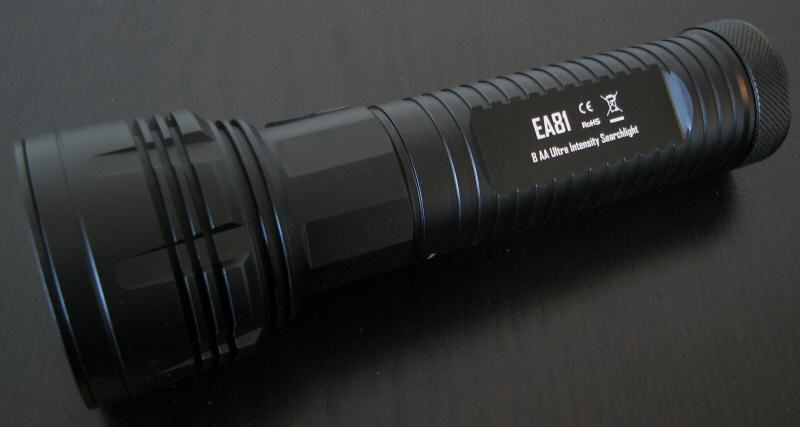
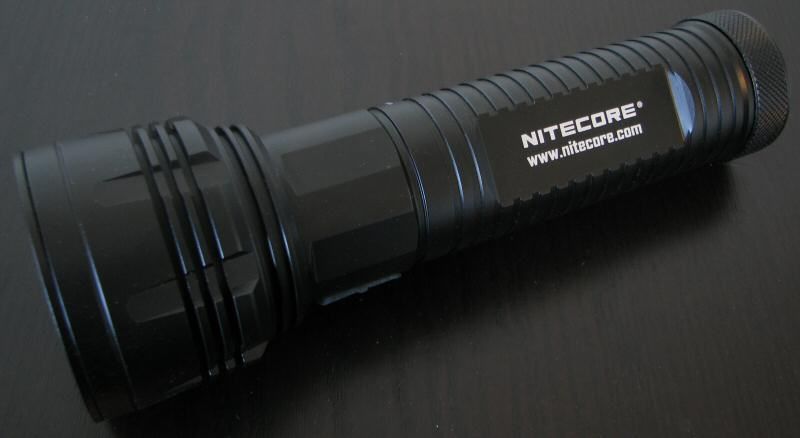
Following up on the EA8 (originally released in early 2013), Nitecore has released a new 8xAA light - the EA81. Featuring the high-output Cree XHP50 emitter, let's see how it compares to others in this class. :wave:
Manufacturer Reported Specifications:
(note: as always, these are simply what the manufacturer provides – scroll down to see my actual testing results).
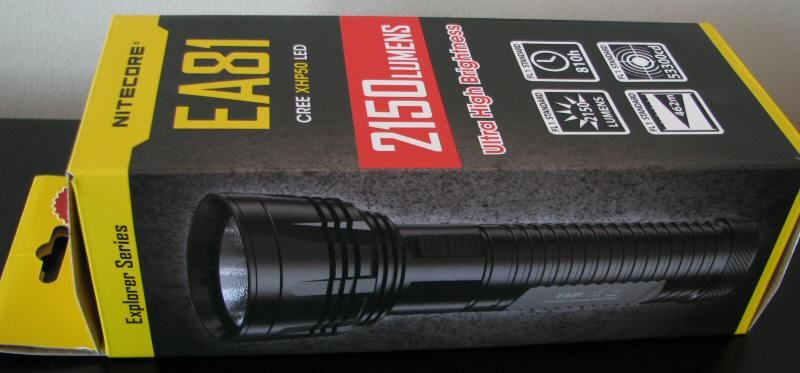
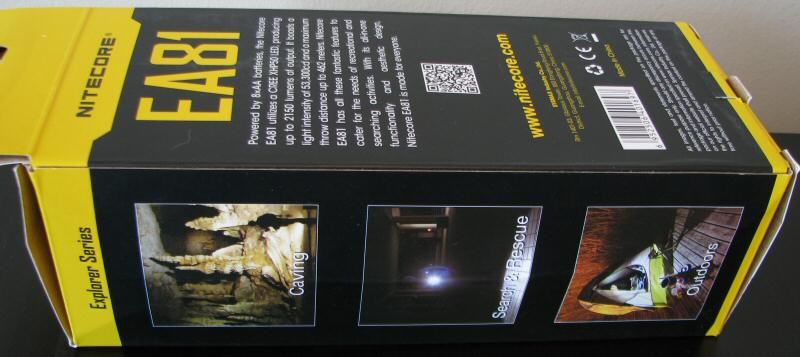
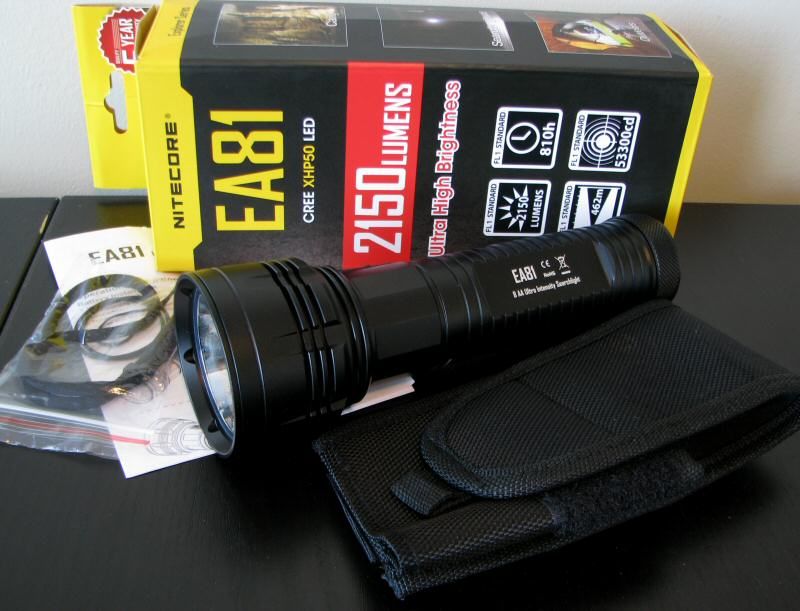
The EA81 comes in similar packaging to the other Nitecore Explorer series lights. Inside the cardboard box, you will find the light, holster, simple wrist lanyard, extra o-ring, manual, and warranty card.
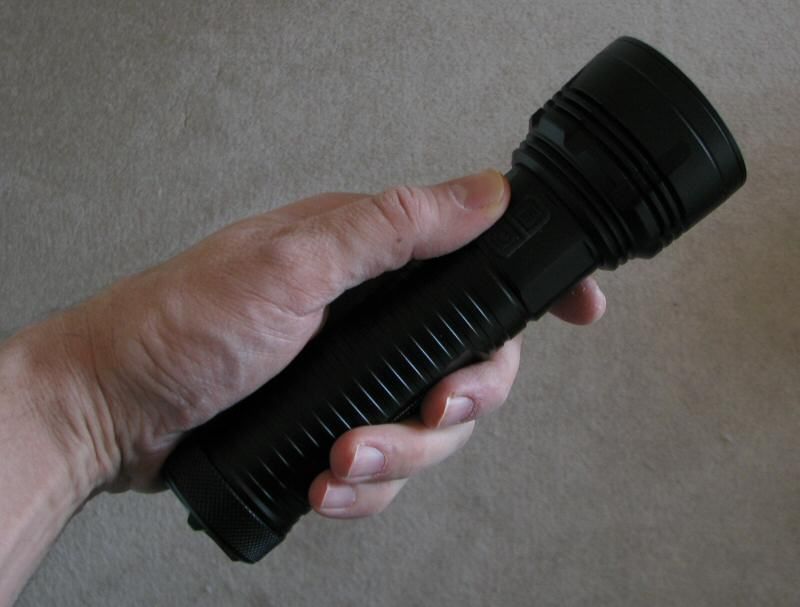
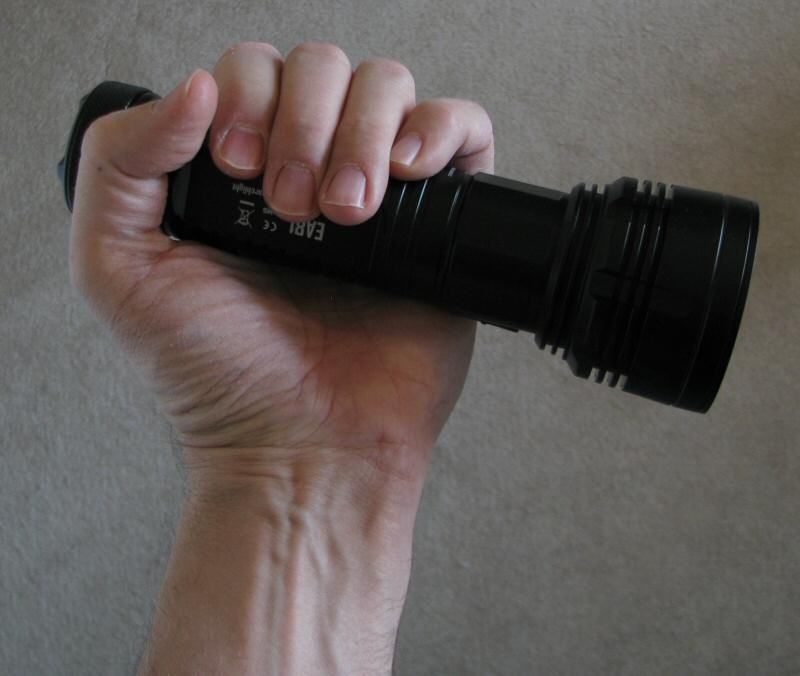
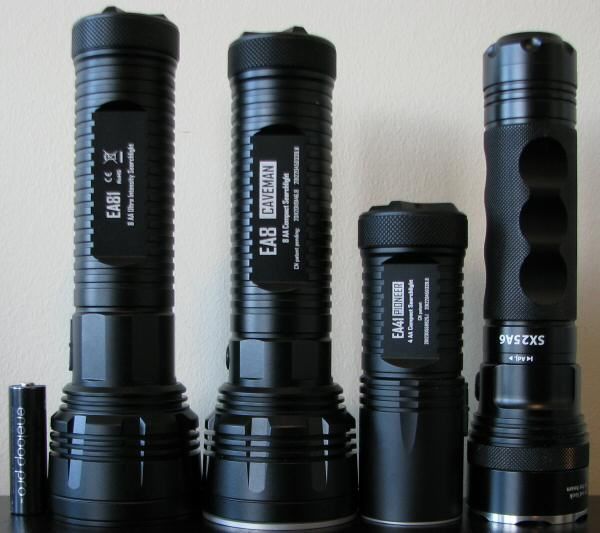
From left to right: Eneloop Pro NiMH; Nitecore EA81, EA8, EA41; Eagletac SX25A6.
All dimensions directly measured, and given with no batteries installed (unless indicated):
6x/8x Lights:
Nitecore EA81 8xAA: Weight: 280.2g , Length: 191mm, Width (bezel): 60.1mm
Nitecore EA8 8xAA: Weight: 301.9g , Length: 182mm, Width (bezel): 60.1mm
Eagletac SX25A6 6xAA: Weight: 279.8g, Length: 183mm, Weight (bezel): 47.0mm
Fenix TK45 8xAA: Weight: 307.3g, Length: 202mm, Width (bezel) 50.6mm, Width (tailcap) 44.0
ITP A6 6xAA: Weight: 209.9g, Length: 174mm, Width (bezel) 48.0mm, Width (tailcap) 37.8mm
Lumintop PK30 6xAA: Weight: 454.0g, Length: 218mm, Width (bezel): 62.0mm
Olight S65 6xAA: Weight 215.4g, Length: 180mm, Width (bezel): 38.7mm
4x Lights:
Fenix E41 4xAA: Weight: 204.1g , Length: 115.9mm, Width (bezel): 44.1mm
JetBeam SRA40 4xAA: Weight 236.0g, Length: 126.1mm, Width (bezel): 48.5mm
Nitecore EA41 2015 4xAA: Weight: 147.9g , Length: 118.4mm, Width (bezel): 40.1mm
Sunwayman D40A 4xAA: Weight: 167.9g, Length: 120.4mm, Width (bezel): 40.0mm
Thrunite TN4A 4xAA: Weight: 217.6g, Length: 112.6mm, Width (bezel): 45.5mm, (tail): 42.0mm
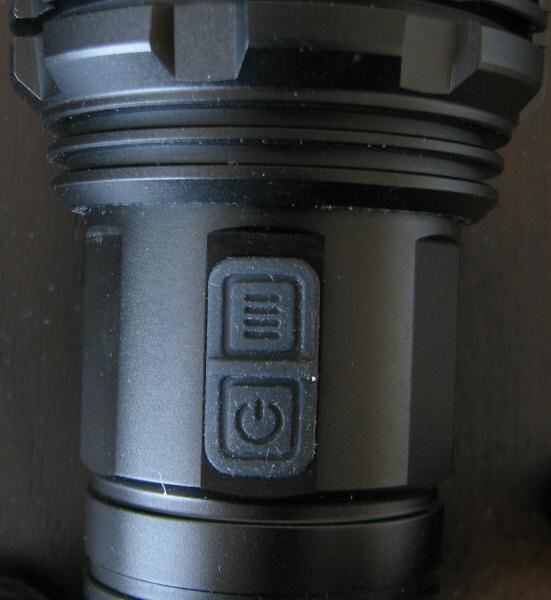
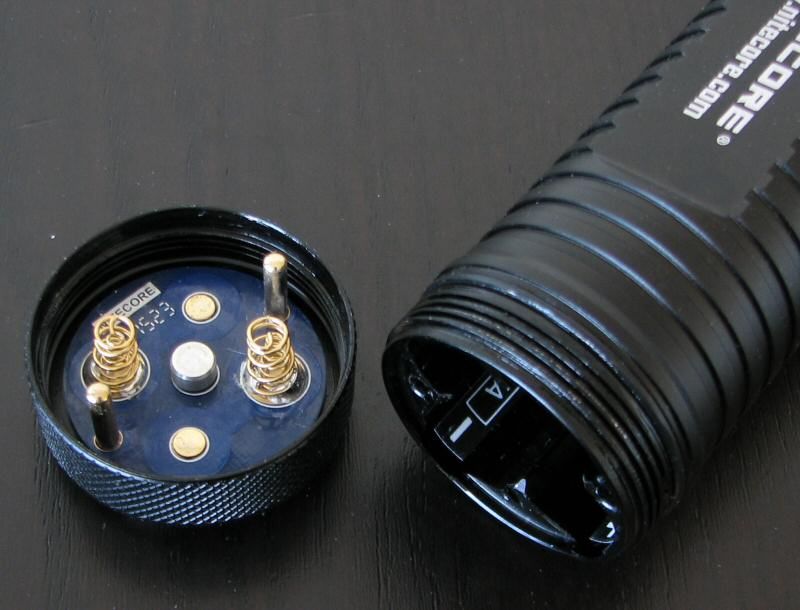
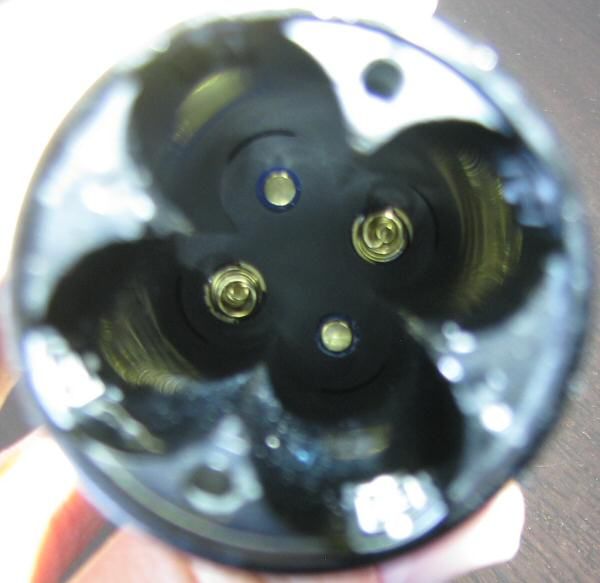
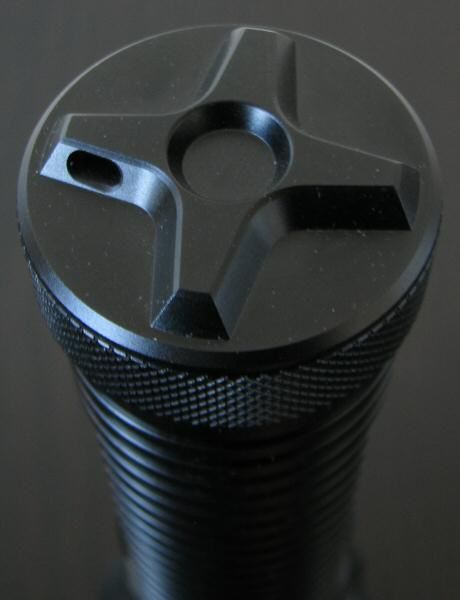
The EA81 shares a lot of similarities to the EA8 – except for the new emitter, dual-switch, and slightly longer body.
As before, there are ridges along the body to help with grip, and there is no knurling except on the tailcap (where it helps when performing battery changes). Overall grip is reasonable. Anodizing is a flat black, and seems in excellent shape on my sample. Body labels are rather extensive, but they are very legible and clear.
The control buttons are similar the EA41. The EA81 now uses two square buttons, located one above the other, as on the EA41. The lower button is the power button, and the upper is the mode changing button (see my User Interface section for more info). Button feel is fairly "grippy", and they are slightly raised.
As before, there is also a single faint blue LED located underneath the switch area. This is used to signal the state of the light (i.e., battery status, standby). Scroll down for an explanation of the interface.
As with many lights of this type, the connection is made by contacts on a connector piece in the tailcap. This connector board can spin freely, and locks in place to a couple of holes in the flashliught body that line up with rods in the tailcap. As with the EA8, screw threads are anodized, but it doesn't matter – there is no physical lock-out, because it is the tension in the springs that determines the contact. In my handling, you will need to loosen the tailcap more than half-way off to even begin to break this contact (i.e., it's not very effective as a lock-out).
Battery handle remains rather compact for 8xAA, the battery compartments are molded right into the aluminum – although the light is a centimeter longer now (likely due to greater heatsinking in the head). Also, the EA81 appears to be 8s1p now (the older EA8 was 4s2p, allowing you to run the light on just 4x AA lights in a pinch).
The light can both tailstand and headstand. There is a cut-out on the base to allow you thread a wrist-lanyard through.
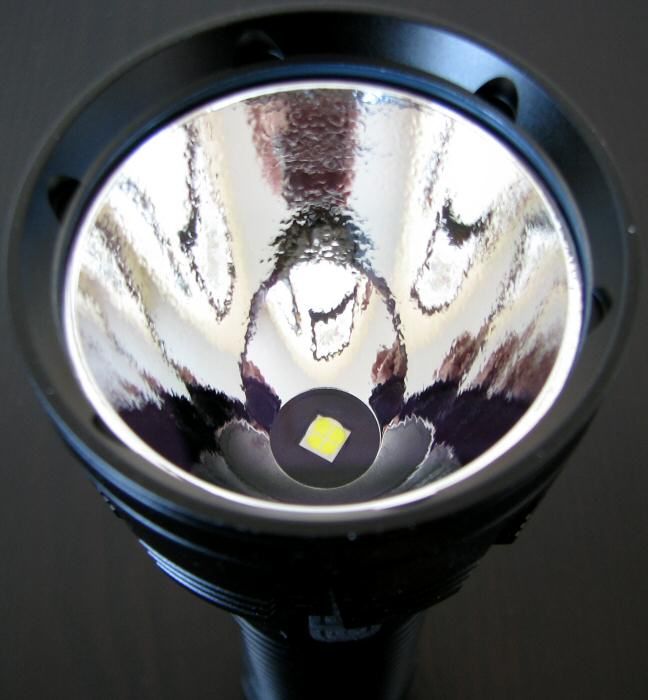
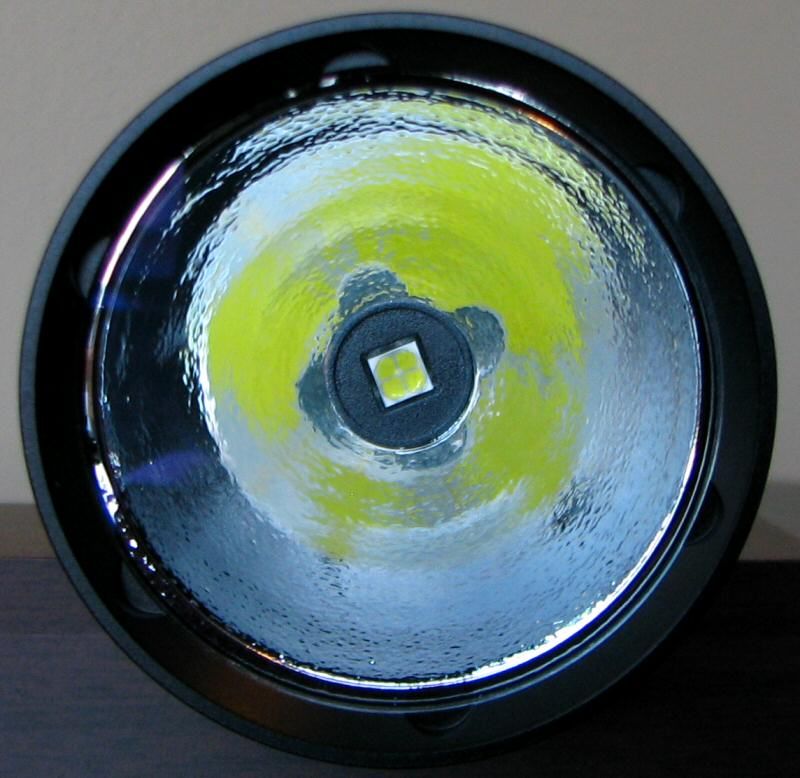
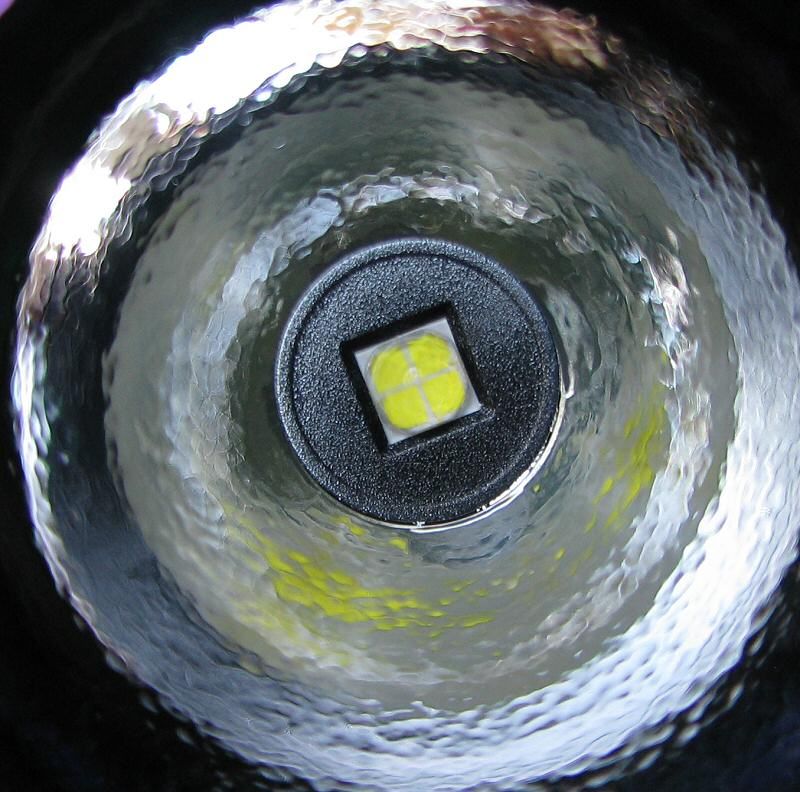
The EA81 reflector is textured and reasonably wide and deep – deeper than old EA8. Note the four-die structure of the XHP50 emitter (Cool White on my sample), which was well centered with a surrounding mask. The light now has a flat black aluminum bezel ring (previously, the EA8 has flat stainless steel bezel ring, in a brushed finish). Scroll down for beamshots.
User Interface
The user interface is the updated from the old EA8, and is now identical to the EA41.
Activation is controlled by the lower power switch – press and release (i.e., click) to turn the light on at the previously memorized constant output level. Click the power switch again to turn off.
While on, click the upper mode switch repeatedly to cycle between the five main output levels in the following repeating sequence: Lower > Lo > Med > Hi > Turbo, in a repeating loop. The light has mode memory, and will return to the last level used when turned back on from off.
For the special modes (i.e., blinking modes), with the light on, press and hold the mode switch for more than 1 sec. The light will enter into Strobe. To advance to Location (aka beacon mode), press and hold the mode switch again. To advance to SOS, press and hold the mode switch again. A click of the mode switch exits back to constant output modes. Note that there is no memory for the blinking modes.
There are a couple of shortcuts available - you can jump directly to Lower or Turbo mode from Off. Press and hold the power switch from Off for more than 1 sec to activate in Lower. Press and hold the mode switch from Off for more than 1 sec for Turbo. Cycle through modes or turn off as before. You can also jump directly to strobe from Off by a double-click of the mode switch.
The light will read-out the voltage of the cells when you first connect the tailcap, by a series of blue flashes under the switch cover. 3 flashes means there is >50% battery life remaining. 2 flashes indicate <50%, and 1 flash means the batteries are almost dead. You can also check the voltage at any time (when Off) my a single click of the Mode switch.
To activate the "special" standby feature, press and hold the power switch when turning Off the light. The faint blue locator LED will flash every ~3 secs in this standby mode. This standby flash is disabled by default.
To lockout the light, you need to start with the light On. Press and hold both buttons for more than 1 sec to electronically lock-out the light. The light will flash once to confirm the lockout. The same sequence (from Off) is required to unlock the light.
Video:
For more information on the overall build and user interface, please see my new video overview:
As with all my videos, I recommend you have annotations turned on. I commonly update the commentary with additional information or clarifications before publicly releasing the video. In this case, I didn't fully explain the EA81 interface – please see the text description above.
As an aside, if you want to get an instant notification for every new review that I post here on CPF, you can subscribe to my YouTube channel (the vids go public at the same time). Just mouse over my logo watermark on the bottom right-hand corner of the video for the subscribe feature to open up.
PWM/Strobe
There is no sign of PWM, at any output level. The EA8 appears to be current-controlled.
EA81 Med:
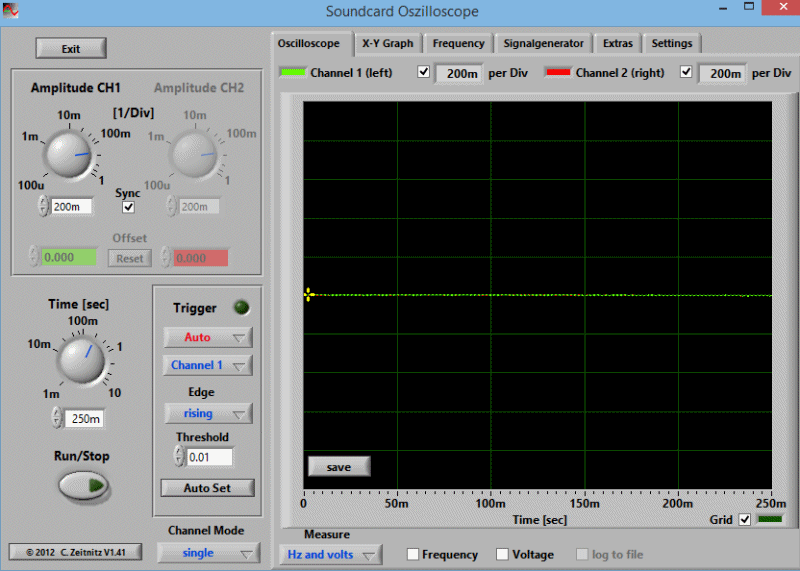
EA81 Strobe:
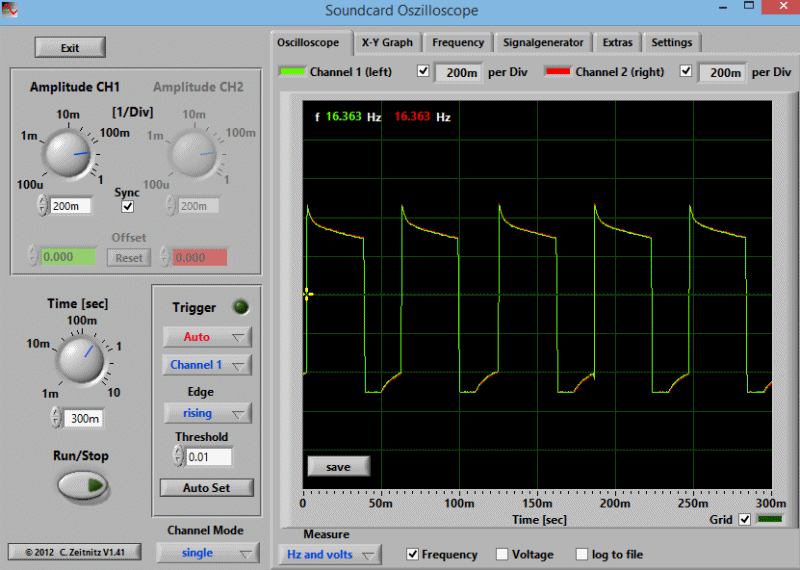
The EA81 uses a fairly typical fast ~16.3 Hz strobe. The On phase is not as long as the Off phase for each pulse however.
EA81 SOS:
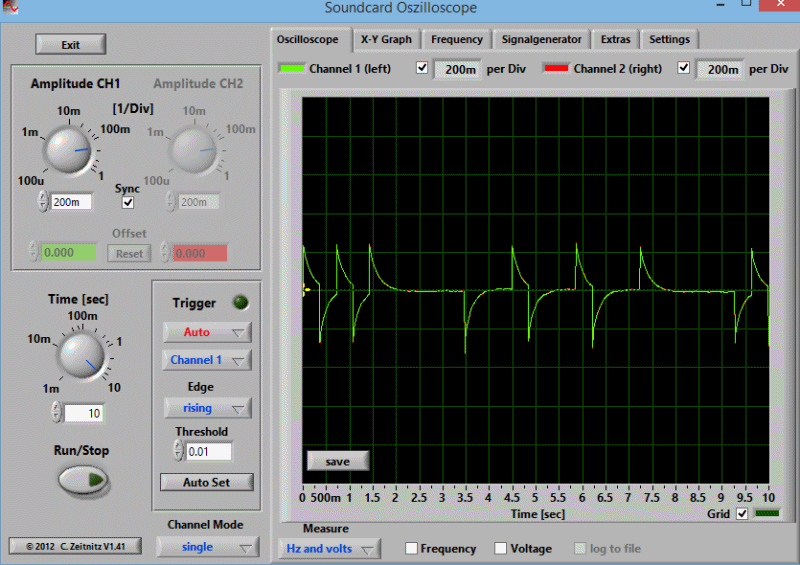
A fairly typical SOS mode.
EA81 Beacon:
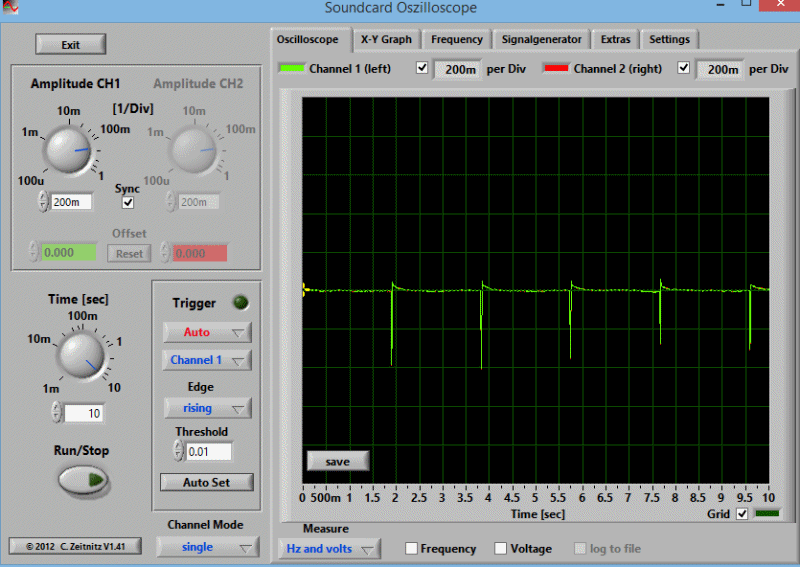
Beacon is a quick flash every ~2 secs or so.
Standby Drain
A standby current drain is inevitable on this light, due to the electronic switch in the head. Unfortunately, due to the 8s1p arrangement, I haven't been able to measure it.
On most Nitecore lights, it tends to be in the low mA range, providing at least several months before the batteries would be drained. The electronic lock-out mode frequently lowers this drain further (but doesn't abolish it). You would really need to store the light without the tailcap in place to make sure there was no drain. :shrug:
Beamshots:
And now the white-wall beamshots. All lights are on Sanyo Eneloop NiMH, at the maximum supported number for the given models (4x or 8x). Lights are about ~0.75 meter from a white wall (with the camera ~1.25 meters back from the wall). Automatic white balance on the camera, to minimize tint differences.
All lights are on Sanyo Eneloop NiMH, at the maximum supported number for the given models (4x or 8x). Lights are about ~0.75 meter from a white wall (with the camera ~1.25 meters back from the wall). Automatic white balance on the camera, to minimize tint differences.
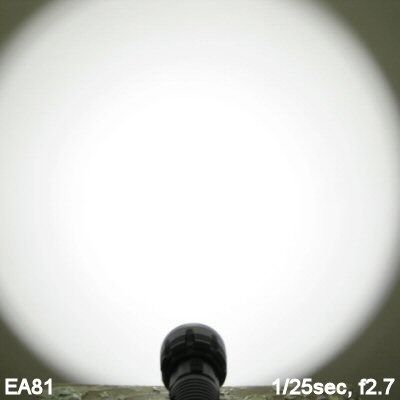
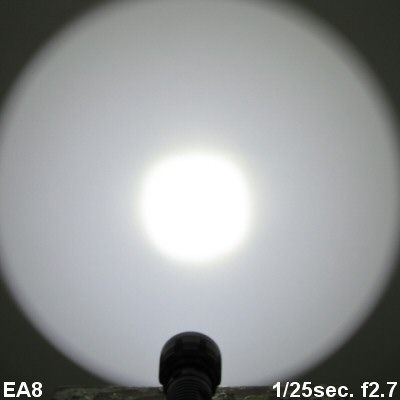
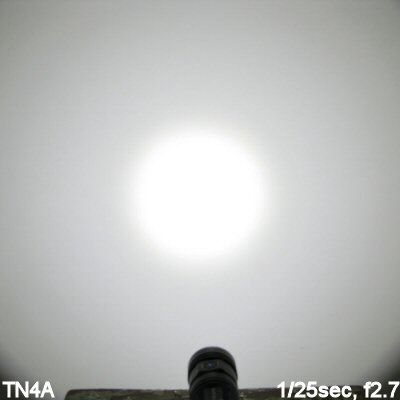
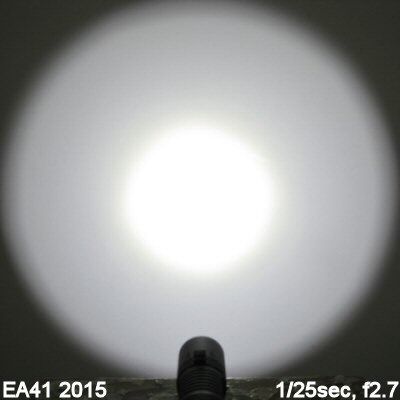
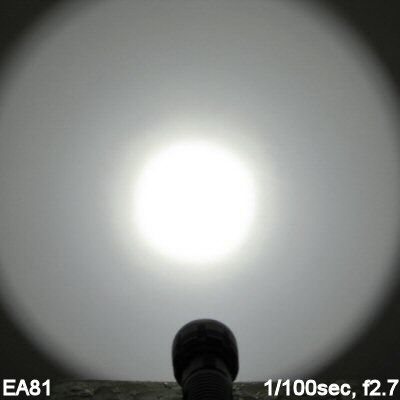
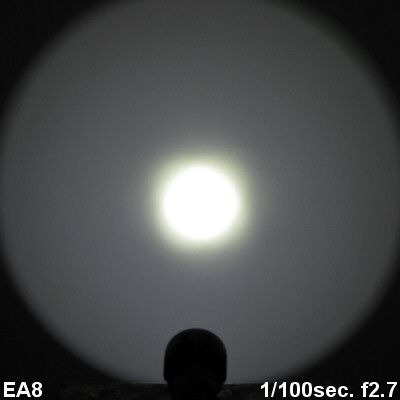
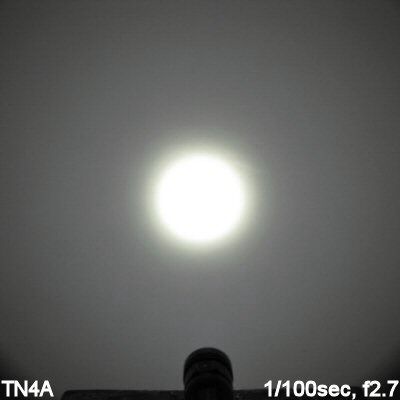
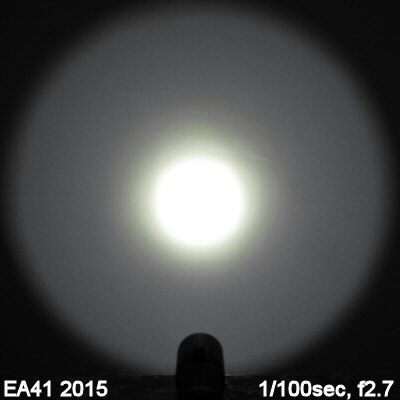
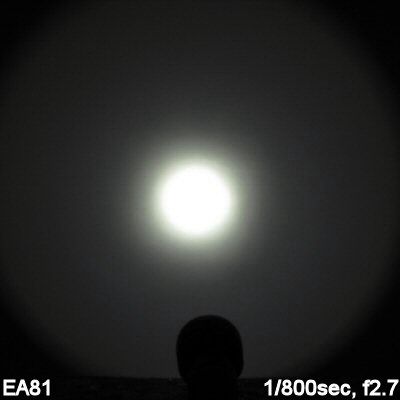
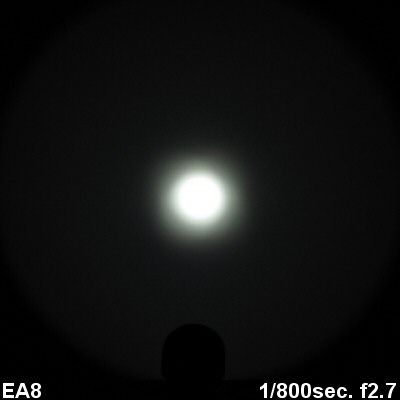
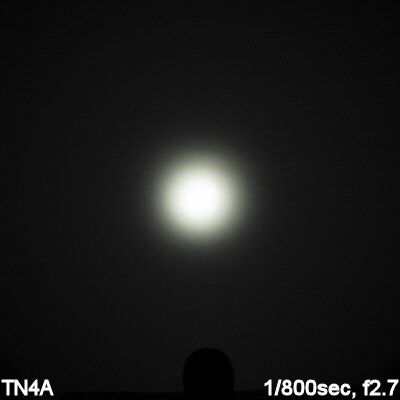
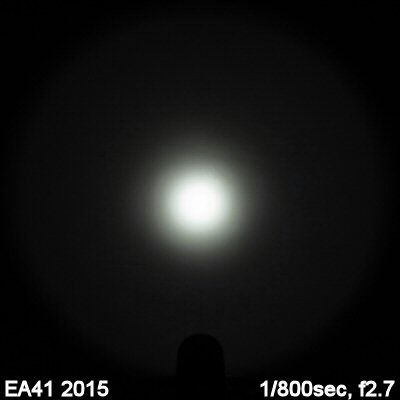
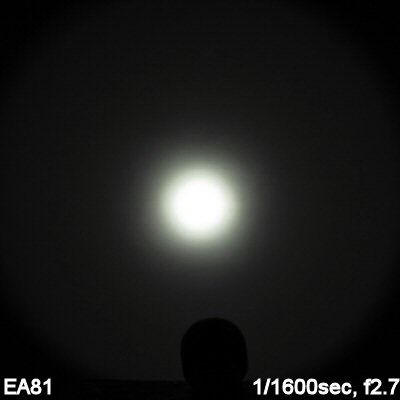
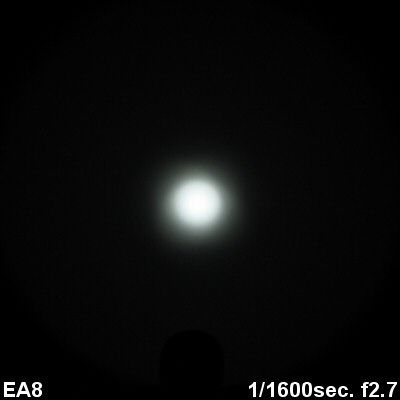
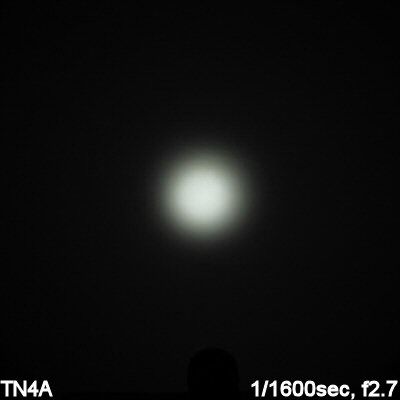
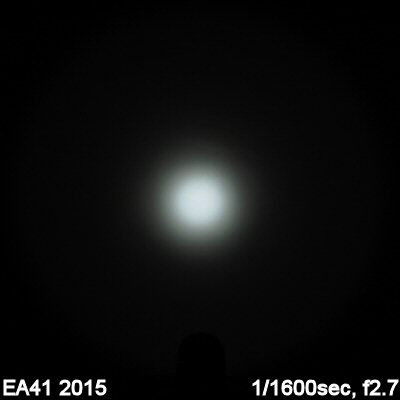
Max output is impressive for an AA-based light – scroll down for actual output measures.
You can't really see it in the max output beamshots above, but there is a definite "donut" effect in the hotspot (i.e., the center is darker than the surround). Up close, you can see this is actually more of a 4-headed clover-leaf effect. It is due to the four-die arrangement of the XHP50 emitter, where no light is produced at the gap between segments. Unfortunately, the textured reflector is not helping much with obscuring this artifact. See my video overview for a better illustration of the effect.
Testing Method:
All my output numbers are relative for my home-made light box setup, as described on my flashlightreviews.ca website. You can directly compare all my relative output values from different reviews - i.e. an output value of "10" in one graph is the same as "10" in another. All runtimes are done under a cooling fan, except for any extended run Lo/Min modes (i.e. >12 hours) which are done without cooling.
I have devised a method for converting my lightbox relative output values (ROV) to estimated Lumens. See my How to convert Selfbuilt's Lightbox values to Lumens thread for more info.
Throw/Output Summary Chart:
My summary tables are reported in a manner consistent with the ANSI FL-1 standard for flashlight testing. Please see http://www.flashlightreviews.ca/FL1.htm for a discussion, and a description of all the terms used in these tables. Effective July 2012, I have updated all my Peak Intensity/Beam Distance measures with a NIST-certified Extech EA31 lightmeter (orange highlights).
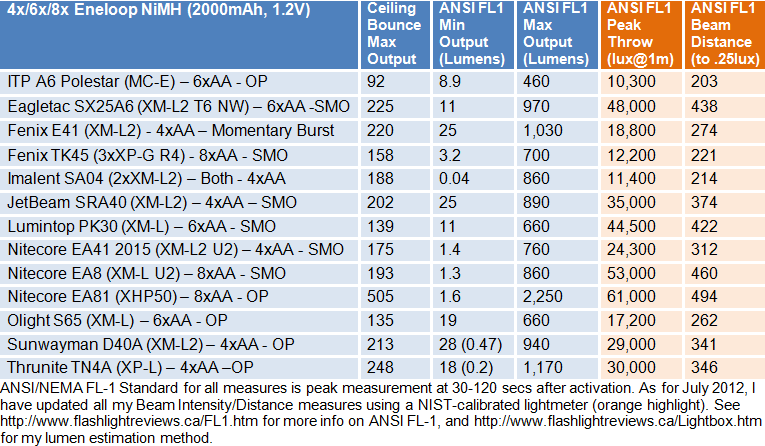
As you could tell from the beamshots, the EA81 has the highest output any mutli-AA light in my collection. Max output is very impressive. Note that the peak intensity throw measure is exactly that – the maximum intensity in the beam. Due to the center dark spot, the center intensity is only ~50,000 cd.
Max output is very impressive. Note that the peak intensity throw measure is exactly that – the maximum intensity in the beam. Due to the center dark spot, the center intensity is only ~50,000 cd.
Here is how my lumen estimates compare to the Nitecore specs for the EA81:
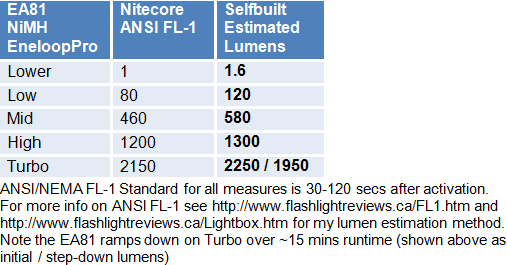
I actually find consistently higher output than the Nitecore specs would indicate, at all levels (although generally concordance is pretty good). :thumbsup:
Output/Runtime Graphs:
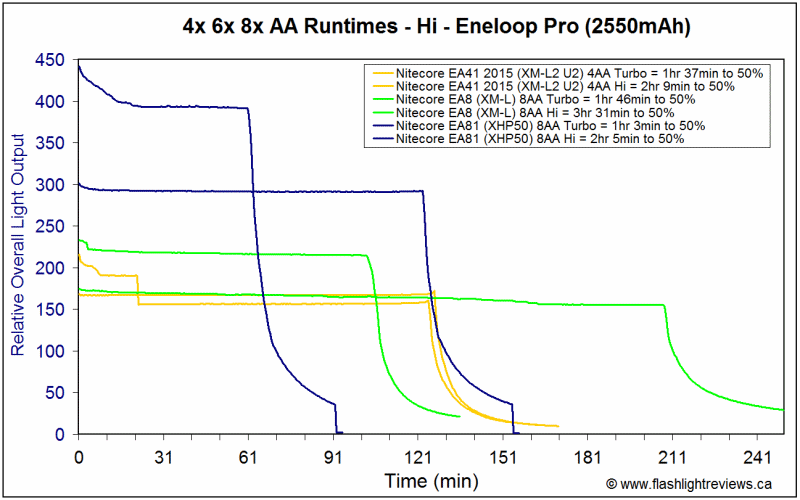
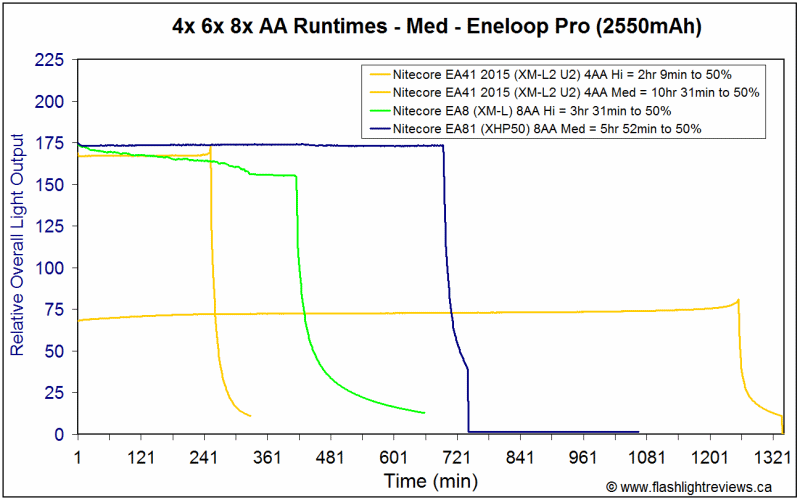

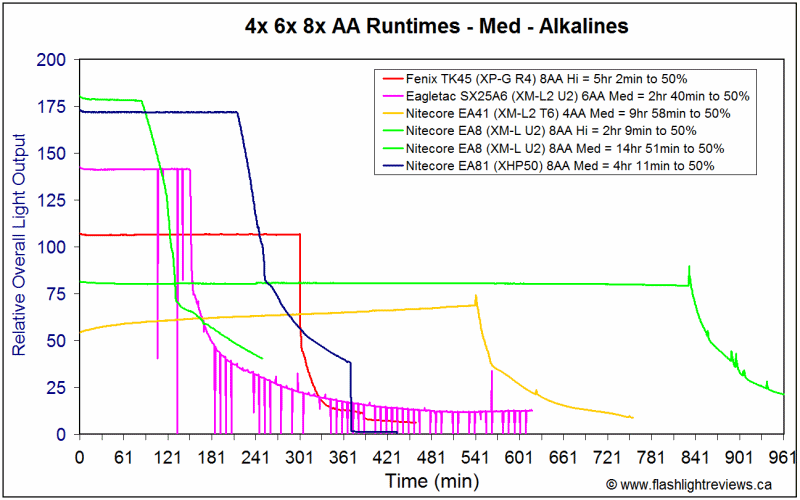
Clearly, there is a huge output jump on the EA81. The older EA8 wasn't much brighter than the 4xAA EA4/EA41 (likely due to the use of the same emitter, and the 4s2p configuration). Basically, the EA8 was just a slightly throwier and longer running version of the EA4.
The EA81 has excellent regulation over its various runtimes (except for alkaline on Turbo, of course). There is a gradual reduction in output on Turbo on NiMH over the first ~15 mins or so, followed by a leveling off.
Overall output/runtime efficiency seems excellent on all batteries. The XHP50 emitter is definitely more efficient than older XM-L (E8) or XM-L2 (EA41).
Potential Issues
Due to the electronic switch in the head, the light has a stand-by current when waiting to receive a button press. This current is likely relatively low (based on other Nitecore lights), but I was not able to measure it here. I recommend that at a minimum, you store the light locked-out at the electronic switch, which should lower the standby current.
You cannot easily lock out the light physically, so I also recommend you use the electronic lock-out in regular use to prevent accidental activations.
My sample has a noticeable center beam dark area, due to the 4-die design of the XHP50 emitter.
Like the EA8, the EA81 rolls easily.
Preliminary Observations
The EA81 is a significant output upgrade from Nitecore - the EA81 is by far the highest output AA-based light that I have tested to date. oo:
oo:
I am glad to see that the two-switch user interface from the popular EA41 has been ported to this new 8xAA model. This solves a lot of the use issues of the original EA8 – two switches are just a lot more intuitive, and don't require learning specific timings or pressure levels. Nitecore wisely included shortcuts to jump to Max or Min output from off (in addition to typical mode memory). :thumbsup: You can even jump to Strobe from off by a double-click of the mode switch.
The output increase is significant, and finally takes full advantage of the extra batteries. On the original EA8, you got basically twice the runtime of the EA4/EA41 models, but little increase in output (due to the emitter choice, and 4s2p cell arrangement). But the XHP50 emitter here provides for a lot more possible output.
Overall output/runtime efficiency is excellent, consistent with a good current-controlled circuit. I am particularly impressed by the regulation pattern on NiMH – the EA81 is able to keep flat regulation for a good amount of time, even on Turbo (after a gradual minor step-down). :thumbsup:
Is there anything not to like? Well, there is a significant visible dark spot in the center of the beam on my sample. Honestly, I've not seen one this pronounced since the old MC-E emitter days. :shrug: And the tailcap design means that there is always a standby drain when batteries are installed (i.e., no way to physically lock out the light, as before).
If you want to stick with standard AA batteries (and don't mind the size of an 8x model), the EA81 definitely has impressive output. Coupled with a very good user interface, there is a lot to like here.
----
EA81 was supplied by Nitecore for review.


Following up on the EA8 (originally released in early 2013), Nitecore has released a new 8xAA light - the EA81. Featuring the high-output Cree XHP50 emitter, let's see how it compares to others in this class. :wave:
Manufacturer Reported Specifications:
(note: as always, these are simply what the manufacturer provides – scroll down to see my actual testing results).
- LED: CREE XHP50
- Output / Runtimes: 2150 Lumens / 1 Hour 45 Minutes, 1200 Lumens / 2 Hours 30 Minutes, 460 Lumens / 7 Hours, 80 Lumens / 32 Hours, 1 Lumen / 810 Hours
- Beam Distance: 462 Meters
- Peak Beam Intensity: 53300cd
- Reflector Style: Orange Peel
- Runs on 8 x AA Batteries (Alkaline, NiMh, Lithium Primary)
- Five brightness levels and three special modes to select from
- Advanced Temperature Regulation (ATR) technology
- Direct access to ultra low and turbo modes
- Innovative dual switch offers user-friendly interface
- Integrated power indicator light displays remaining battery power
- Reverse polarity protection prevents damage from incorrectly inserted batteries
- Stainless steel retaining ring protects core components from damage
- Toughened ultra-clear mineral glass lens with anti-reflective coating
- Constructed from aerospace-grade aluminum alloy
- Robust HAIII military grade hard-anodized
- Waterproof in accordance with IPX-8 (two-meter submersible)
- 1.5 meter impact resistance
- Tail stand capability
- Dimensions: Length: 193 mm, Head Size: 60 mm, Weight: 282g
- Included accessories: Holster, Lanyard, Spare O-Ring,
- MSRP: ~$120



The EA81 comes in similar packaging to the other Nitecore Explorer series lights. Inside the cardboard box, you will find the light, holster, simple wrist lanyard, extra o-ring, manual, and warranty card.



From left to right: Eneloop Pro NiMH; Nitecore EA81, EA8, EA41; Eagletac SX25A6.
All dimensions directly measured, and given with no batteries installed (unless indicated):
6x/8x Lights:
Nitecore EA81 8xAA: Weight: 280.2g , Length: 191mm, Width (bezel): 60.1mm
Nitecore EA8 8xAA: Weight: 301.9g , Length: 182mm, Width (bezel): 60.1mm
Eagletac SX25A6 6xAA: Weight: 279.8g, Length: 183mm, Weight (bezel): 47.0mm
Fenix TK45 8xAA: Weight: 307.3g, Length: 202mm, Width (bezel) 50.6mm, Width (tailcap) 44.0
ITP A6 6xAA: Weight: 209.9g, Length: 174mm, Width (bezel) 48.0mm, Width (tailcap) 37.8mm
Lumintop PK30 6xAA: Weight: 454.0g, Length: 218mm, Width (bezel): 62.0mm
Olight S65 6xAA: Weight 215.4g, Length: 180mm, Width (bezel): 38.7mm
4x Lights:
Fenix E41 4xAA: Weight: 204.1g , Length: 115.9mm, Width (bezel): 44.1mm
JetBeam SRA40 4xAA: Weight 236.0g, Length: 126.1mm, Width (bezel): 48.5mm
Nitecore EA41 2015 4xAA: Weight: 147.9g , Length: 118.4mm, Width (bezel): 40.1mm
Sunwayman D40A 4xAA: Weight: 167.9g, Length: 120.4mm, Width (bezel): 40.0mm
Thrunite TN4A 4xAA: Weight: 217.6g, Length: 112.6mm, Width (bezel): 45.5mm, (tail): 42.0mm




The EA81 shares a lot of similarities to the EA8 – except for the new emitter, dual-switch, and slightly longer body.
As before, there are ridges along the body to help with grip, and there is no knurling except on the tailcap (where it helps when performing battery changes). Overall grip is reasonable. Anodizing is a flat black, and seems in excellent shape on my sample. Body labels are rather extensive, but they are very legible and clear.
The control buttons are similar the EA41. The EA81 now uses two square buttons, located one above the other, as on the EA41. The lower button is the power button, and the upper is the mode changing button (see my User Interface section for more info). Button feel is fairly "grippy", and they are slightly raised.
As before, there is also a single faint blue LED located underneath the switch area. This is used to signal the state of the light (i.e., battery status, standby). Scroll down for an explanation of the interface.
As with many lights of this type, the connection is made by contacts on a connector piece in the tailcap. This connector board can spin freely, and locks in place to a couple of holes in the flashliught body that line up with rods in the tailcap. As with the EA8, screw threads are anodized, but it doesn't matter – there is no physical lock-out, because it is the tension in the springs that determines the contact. In my handling, you will need to loosen the tailcap more than half-way off to even begin to break this contact (i.e., it's not very effective as a lock-out).
Battery handle remains rather compact for 8xAA, the battery compartments are molded right into the aluminum – although the light is a centimeter longer now (likely due to greater heatsinking in the head). Also, the EA81 appears to be 8s1p now (the older EA8 was 4s2p, allowing you to run the light on just 4x AA lights in a pinch).
The light can both tailstand and headstand. There is a cut-out on the base to allow you thread a wrist-lanyard through.



The EA81 reflector is textured and reasonably wide and deep – deeper than old EA8. Note the four-die structure of the XHP50 emitter (Cool White on my sample), which was well centered with a surrounding mask. The light now has a flat black aluminum bezel ring (previously, the EA8 has flat stainless steel bezel ring, in a brushed finish). Scroll down for beamshots.
User Interface
The user interface is the updated from the old EA8, and is now identical to the EA41.
Activation is controlled by the lower power switch – press and release (i.e., click) to turn the light on at the previously memorized constant output level. Click the power switch again to turn off.
While on, click the upper mode switch repeatedly to cycle between the five main output levels in the following repeating sequence: Lower > Lo > Med > Hi > Turbo, in a repeating loop. The light has mode memory, and will return to the last level used when turned back on from off.
For the special modes (i.e., blinking modes), with the light on, press and hold the mode switch for more than 1 sec. The light will enter into Strobe. To advance to Location (aka beacon mode), press and hold the mode switch again. To advance to SOS, press and hold the mode switch again. A click of the mode switch exits back to constant output modes. Note that there is no memory for the blinking modes.
There are a couple of shortcuts available - you can jump directly to Lower or Turbo mode from Off. Press and hold the power switch from Off for more than 1 sec to activate in Lower. Press and hold the mode switch from Off for more than 1 sec for Turbo. Cycle through modes or turn off as before. You can also jump directly to strobe from Off by a double-click of the mode switch.
The light will read-out the voltage of the cells when you first connect the tailcap, by a series of blue flashes under the switch cover. 3 flashes means there is >50% battery life remaining. 2 flashes indicate <50%, and 1 flash means the batteries are almost dead. You can also check the voltage at any time (when Off) my a single click of the Mode switch.
To activate the "special" standby feature, press and hold the power switch when turning Off the light. The faint blue locator LED will flash every ~3 secs in this standby mode. This standby flash is disabled by default.
To lockout the light, you need to start with the light On. Press and hold both buttons for more than 1 sec to electronically lock-out the light. The light will flash once to confirm the lockout. The same sequence (from Off) is required to unlock the light.
Video:
For more information on the overall build and user interface, please see my new video overview:
As with all my videos, I recommend you have annotations turned on. I commonly update the commentary with additional information or clarifications before publicly releasing the video. In this case, I didn't fully explain the EA81 interface – please see the text description above.
As an aside, if you want to get an instant notification for every new review that I post here on CPF, you can subscribe to my YouTube channel (the vids go public at the same time). Just mouse over my logo watermark on the bottom right-hand corner of the video for the subscribe feature to open up.
PWM/Strobe
There is no sign of PWM, at any output level. The EA8 appears to be current-controlled.
EA81 Med:

EA81 Strobe:

The EA81 uses a fairly typical fast ~16.3 Hz strobe. The On phase is not as long as the Off phase for each pulse however.
EA81 SOS:

A fairly typical SOS mode.
EA81 Beacon:
Beacon is a quick flash every ~2 secs or so.
Standby Drain
A standby current drain is inevitable on this light, due to the electronic switch in the head. Unfortunately, due to the 8s1p arrangement, I haven't been able to measure it.
On most Nitecore lights, it tends to be in the low mA range, providing at least several months before the batteries would be drained. The electronic lock-out mode frequently lowers this drain further (but doesn't abolish it). You would really need to store the light without the tailcap in place to make sure there was no drain. :shrug:
Beamshots:
And now the white-wall beamshots.
















Max output is impressive for an AA-based light – scroll down for actual output measures.
You can't really see it in the max output beamshots above, but there is a definite "donut" effect in the hotspot (i.e., the center is darker than the surround). Up close, you can see this is actually more of a 4-headed clover-leaf effect. It is due to the four-die arrangement of the XHP50 emitter, where no light is produced at the gap between segments. Unfortunately, the textured reflector is not helping much with obscuring this artifact. See my video overview for a better illustration of the effect.
Testing Method:
All my output numbers are relative for my home-made light box setup, as described on my flashlightreviews.ca website. You can directly compare all my relative output values from different reviews - i.e. an output value of "10" in one graph is the same as "10" in another. All runtimes are done under a cooling fan, except for any extended run Lo/Min modes (i.e. >12 hours) which are done without cooling.
I have devised a method for converting my lightbox relative output values (ROV) to estimated Lumens. See my How to convert Selfbuilt's Lightbox values to Lumens thread for more info.
Throw/Output Summary Chart:
My summary tables are reported in a manner consistent with the ANSI FL-1 standard for flashlight testing. Please see http://www.flashlightreviews.ca/FL1.htm for a discussion, and a description of all the terms used in these tables. Effective July 2012, I have updated all my Peak Intensity/Beam Distance measures with a NIST-certified Extech EA31 lightmeter (orange highlights).

As you could tell from the beamshots, the EA81 has the highest output any mutli-AA light in my collection.
Here is how my lumen estimates compare to the Nitecore specs for the EA81:

I actually find consistently higher output than the Nitecore specs would indicate, at all levels (although generally concordance is pretty good). :thumbsup:
Output/Runtime Graphs:




Clearly, there is a huge output jump on the EA81. The older EA8 wasn't much brighter than the 4xAA EA4/EA41 (likely due to the use of the same emitter, and the 4s2p configuration). Basically, the EA8 was just a slightly throwier and longer running version of the EA4.
The EA81 has excellent regulation over its various runtimes (except for alkaline on Turbo, of course). There is a gradual reduction in output on Turbo on NiMH over the first ~15 mins or so, followed by a leveling off.
Overall output/runtime efficiency seems excellent on all batteries. The XHP50 emitter is definitely more efficient than older XM-L (E8) or XM-L2 (EA41).
Potential Issues
Due to the electronic switch in the head, the light has a stand-by current when waiting to receive a button press. This current is likely relatively low (based on other Nitecore lights), but I was not able to measure it here. I recommend that at a minimum, you store the light locked-out at the electronic switch, which should lower the standby current.
You cannot easily lock out the light physically, so I also recommend you use the electronic lock-out in regular use to prevent accidental activations.
My sample has a noticeable center beam dark area, due to the 4-die design of the XHP50 emitter.
Like the EA8, the EA81 rolls easily.
Preliminary Observations
The EA81 is a significant output upgrade from Nitecore - the EA81 is by far the highest output AA-based light that I have tested to date.
I am glad to see that the two-switch user interface from the popular EA41 has been ported to this new 8xAA model. This solves a lot of the use issues of the original EA8 – two switches are just a lot more intuitive, and don't require learning specific timings or pressure levels. Nitecore wisely included shortcuts to jump to Max or Min output from off (in addition to typical mode memory). :thumbsup: You can even jump to Strobe from off by a double-click of the mode switch.
The output increase is significant, and finally takes full advantage of the extra batteries. On the original EA8, you got basically twice the runtime of the EA4/EA41 models, but little increase in output (due to the emitter choice, and 4s2p cell arrangement). But the XHP50 emitter here provides for a lot more possible output.
Overall output/runtime efficiency is excellent, consistent with a good current-controlled circuit. I am particularly impressed by the regulation pattern on NiMH – the EA81 is able to keep flat regulation for a good amount of time, even on Turbo (after a gradual minor step-down). :thumbsup:
Is there anything not to like? Well, there is a significant visible dark spot in the center of the beam on my sample. Honestly, I've not seen one this pronounced since the old MC-E emitter days. :shrug: And the tailcap design means that there is always a standby drain when batteries are installed (i.e., no way to physically lock out the light, as before).
If you want to stick with standard AA batteries (and don't mind the size of an 8x model), the EA81 definitely has impressive output. Coupled with a very good user interface, there is a lot to like here.
----
EA81 was supplied by Nitecore for review.

